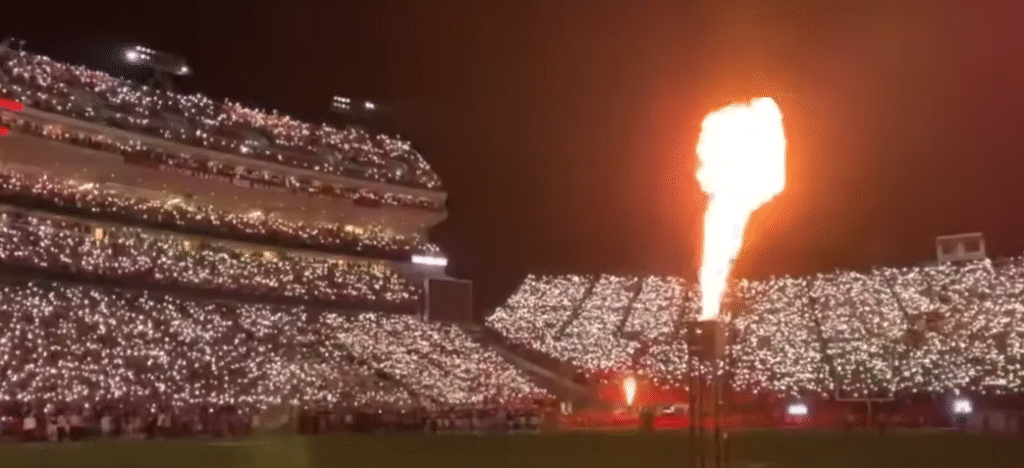Memorial Stadium in Nebraska has always been more than just a steel structure and seats. Only a portion of its stated capacity of 85,458 is revealed. It has stood for decades as a symbol of devotion, continuity, and the kind of camaraderie that other college towns try to imitate but seldom succeed in. This venue’s allure is demonstrated by the fact that every home game since 1962 has sold out. That streak effectively illustrates how sports can become ingrained in a community’s identity.
It wasn’t an easy or clear path to reach today’s capacity. The stadium could only hold slightly more than 31,000 spectators when it first opened in 1923. Similar to how a successful movie franchise reinvents itself every ten years with bigger budgets and higher stakes, expansion projects were started over time. End zone seating doubled in size by the 1960s, and press facilities and opulent suites were added in subsequent decades. Every new addition emphasized how sports, culture, and business are increasingly overlapping.
The East Stadium expansion in 2013 increased the stadium’s capacity to over 87,000, briefly placing Nebraska among the best in terms of size. However, a few years later, seats were expanded, bringing the total down to 85,458 today. Although that change was especially helpful for fan comfort, it also generated controversy. While some hailed the change as a considerate response to contemporary expectations, others contended that fewer fans diminished the menacing “Sea of Red.” The discussion felt remarkably similar to discussions about airlines striking a balance between legroom and ticket sales, where tradition and comfort collide.
Table: Nebraska Memorial Stadium Key Facts
| Category | Details |
|---|---|
| Stadium Name | Tom Osborne Field at Memorial Stadium |
| Location | 600 Stadium Drive, Lincoln, Nebraska, U.S. |
| Opened | October 13, 1923 |
| Capacity | 85,458 (2017–present) |
| Record Attendance | 92,003 (Volleyball, Aug. 30, 2023) |
| Primary Tenant | Nebraska Cornhuskers Football |
| Surface | FieldTurf (1999–present), returning to grass in 2026 |
| Renovations | 1967, 1994, 2000, 2006, 2013, 2026 (planned) |
| Owner/Operator | University of Nebraska–Lincoln |
| Nickname | “The Sea of Red” |
| Reference | Memorial Stadium – Wikipedia |

However, there have been moments at the stadium that go beyond football. An incredible 92,003 spectators packed Memorial Stadium for Volleyball Day in 2023, setting a new attendance record for women’s sports. The field was changed that day, and it appeared to have an infinite capacity. It served as a reminder that, despite being built for football, this structure has evolved into one that is remarkably adaptable and can now support women’s sports in previously unthinkable ways.
The limits of capacity have also been pushed by well-known concerts. Similar to how Taylor Swift’s Eras Tour packed NFL stadiums from coast to coast, Garth Brooks’ 2021 performance drew close to 90,000. Stadiums were transformed into cultural theaters in both instances, where memory and music blended together. Those performances served as a reminder to Nebraska that its football stadium was a stage on a national scale that could effortlessly switch between touchdowns and encores.
Plans for renovations have added a new chapter to this developing narrative. Seating could be reduced by 15,000 as part of a $450 million project at South Stadium to replace the bleachers with wider chair-backs. It was controversial to reduce the size of a stadium that took great pride in its sheer size. Troy Dannen, the athletic director, acknowledged that the project was shelved due to the current financial climate of collegiate athletics. However, the stadium’s core is incredibly resilient despite having fewer seats, much like a classic book that retains its value even when it is repackaged in a smaller edition.
The setting, rather than the stadium’s ranking (13th among college stadiums), is what distinguishes Nebraska’s 85,458 capacity. The state routinely fills those seats despite having fewer than two million residents. Similar to how Green Bay supports the NFL’s Packers despite having one of the league’s smallest markets, that ratio is incredibly efficient in and of itself. In Nebraska, the focus is on group devotion rather than just numbers, which has been greatly strengthened by customs like the Tunnel Walk and the balloon release following the first score.
One cannot overestimate the economic impact. Lincoln flourishes on game days as fans fill the hotels, eateries, and retail establishments. In a similar way to how Broadway theaters support Manhattan, the stadium efficiently turns into a massive economic engine that powers nearby companies. Season after season, the steady sellouts have provided surprisingly inexpensive opportunities for small food and merchandise vendors to maintain their livelihoods.
When compared to other stadiums, Nebraska’s unique intimacy and size balance is evident. Although Michigan Stadium has 107,000 seats, Nebraska’s 85,458 creates a loud atmosphere that rivals frequently liken to an avalanche. Design changes like larger video boards and better sound systems have significantly increased the intimidation factor. The goal of these updates, despite their subtlety, has been very clear: to modernize without sacrificing tradition.

